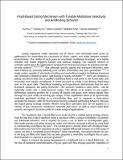| dc.contributor.author | Hou, Xu | |
| dc.contributor.author | Hu, Yuhang | |
| dc.contributor.author | Grinthal, Alison Elizabeth | |
| dc.contributor.author | Khan, Mughees | |
| dc.contributor.author | Aizenberg, Joanna | |
| dc.date.accessioned | 2016-07-13T19:30:03Z | |
| dc.date.issued | 2015 | |
| dc.identifier.citation | Hou, Xu, Yuhang Hu, Alison Grinthal, Mughees Khan, and Joanna Aizenberg. 2015. Liquid-Based Gating Mechanism with Tunable Multiphase Selectivity and Antifouling Behaviour. Nature 519, no. 7541: 70–73. doi:10.1038/nature14253. . | en_US |
| dc.identifier.issn | 0028-0836 | en_US |
| dc.identifier.uri | http://nrs.harvard.edu/urn-3:HUL.InstRepos:27657493 | |
| dc.description.abstract | Living organisms make extensive use of micro- and nanometre-sized pores as gatekeepers for controlling the movement of fluids, vapours and solids between complex environments. The ability of such pores to coordinate multiphase transport, in a highly selective and subtly triggered fashion and without clogging, has inspired interest in synthetic gated pores for applications ranging from fluid processing to 3D printing and lab-on-chip systems. But although specific gating and transport behaviours have been realized by precisely tailoring pore surface chemistries and pore geometries a single system capable of controlling complex, selective multiphase transport has remained a distant prospect, and fouling is nearly inevitable. Here we introduce a gating mechanism that uses a capillary-stabilized liquid as a reversible, reconfigurable gate that fills and seals pores in the closed state, and creates a non-fouling, liquid-lined pore in the open state. Theoretical modelling and experiments demonstrate that for each transport substance, the gating threshold—the pressure needed to open the pores—can be rationally tuned over a wide pressure range. This enables us to realize in one system differential response profiles for a variety of liquids and gases, even letting liquids flow through the pore while preventing gas from escaping. These capabilities allow us to dynamically modulate gas–liquid sorting in a microfluidic flow and to separate a three-phase air–water–oil mixture, with the liquid lining ensuring sustained antifouling behaviour. Because the liquid gating strategy enables efficient long-term operation and can be applied to a variety of pore structures and membrane materials, and to micro- as well as macroscale fluid systems, we expect it to prove useful in a wide range of applications. | en_US |
| dc.description.sponsorship | Engineering and Applied Sciences | en_US |
| dc.language.iso | en_US | en_US |
| dc.publisher | Nature Publishing Group | en_US |
| dc.relation.isversionof | doi:10.1038/nature14253 | en_US |
| dash.license | LAA | |
| dc.subject | nanoscale materials | en_US |
| dc.title | Liquid-based gating mechanism with tunable multiphase selectivity and antifouling behaviour | en_US |
| dc.type | Journal Article | en_US |
| dc.description.version | Accepted Manuscript | en_US |
| dc.relation.journal | Nature | en_US |
| dash.depositing.author | Aizenberg, Joanna | |
| dash.waiver | 2014-12-05 | |
| dc.date.available | 2016-07-13T19:30:03Z | |
| dash.funder.name | Advanced Research Projects Agency-Energy | en_US |
| dash.funder.name | Department of Energy | en_US |
| dash.funder.award | DE-AR0000326 | en_US |
| dc.identifier.doi | 10.1038/nature14253 | * |
| dash.contributor.affiliated | Khan, Mughees | |
| dash.contributor.affiliated | Hou, Xu | |
| dash.contributor.affiliated | Grinthal, Alison | |
| dash.contributor.affiliated | Aizenberg, Joanna | |


